Determination Method of Reasonable Reinforcement Parameters for Subsea Tunnels Considering Ground Reinforcement and Seepage Effect
Abstract
:1. Introduction
2. Mechanical Analysis of Subsea Tunnels Considering Ground Reinforcement
2.1. Analytical Model
2.2. Analytical Solutions for Various Configurations
3. Validation of the Analytical Solutions
3.1. Comparison to Numerical Simulation Results
3.2. Comparison to the Existing Analytical Solutions
4. Optimization Process of the Reinforcement Parameters
- (1)
- First of all, according to the geological prospecting data, tunnel geometric parameters, mechanical parameters, and permeability of surrounding rock can be obtained. Based on the engineering geological conditions and referring to the relevant research and regulations, the control standard of the tunnel radial displacement [u] is evaluated. Thereafter, the actual maximum value of the tunnel radial displacement u is calculated by substituting the natural parameters into the analytical model, and it is compared to the control standard value. If u < [u], objective I can be reached by the surrounding rock itself, one only needs to design based on objective II. If u > [u], the reinforced parameters shall be preliminarily designed according to the displacement control objective.
- (2)
- For objective I, reinforcement parameters including reinforcement thickness, mechanical parameters, and permeability are preliminarily determined by referring to similar projects in combination with the experience of designers. Through the proposed analytical model, the processing path of surrounding rock plastic zone(s) can be determined, the corresponding surrounding rock displacement of each configuration can also be obtained. Then sensitivity analyses of the reinforcement parameters are performed, and these parameters are sorted according to their sensitivity; thereby, the optimal solutions of the relevant parameters affecting the displacement are preliminarily determined. The sensitivity calculation method is introduced in Section 5.
- (3)
- The displacement u1 corresponding to the optimal solution set is obtained, and it is compared with the displacement standard [u], if u1 > [u], the variation ranges of the parameters are expanded to recalculate; if u1 < [u], the parameters in the sequence of their sensitivity to get the surplus space of each parameter are calculated. During solving for the margin of a certain parameter, the other parameters are set equal to their optimal values. By this view, the critical value of the parameter is obtained by taking the displacement control standard as the input.
- (4)
- For objective II, the relevant parameters influencing seepage quantity are analyzed similar to the former phase. The seepage control standard is determined by referring to the relevant engineering experiences, and the optimal value of the hydraulic parameters (namely, the permeability coefficient) is calculated by substituting the optimal solution set into the formula for the seepage quantity.
5. Engineering Application of the Proposed Method
5.1. Project Description of Qingdao Jiaozhou Bay Subsea Tunnel
5.2. Adaptive Analysis of the Proposed Analytical Model in Qingdao Jiaozhou Bay Subsea Tunnel
5.3. Optimization of the Reinforcement Parameters According to Objective I
5.4. Optimization of Hydraulic Parameters According to the Objective II
6. Conclusions
- (1)
- By taking into account the ground reinforcement and seepage effect, the analytical solutions to six configurations with different distributions of plastic zone(s) were provided, which were then validated by numerical simulations as well as existing methods. It was shown that seepage effect has significant influence on tunnel radial displacement, which indicates the benefit of the proposed model in predicting mechanical behavior of subsea tunnels.
- (2)
- Under the given conditions, the main factors affecting the stability of the surrounding rock were identified through sensitivity analysis of the ground reinforcement parameters, which are the internal friction angle followed by the cohesive force and the reinforcement thickness according to the sensitiveness. Nevertheless, the significant effect of each parameter on the displacement is within a certain range, as the parameter increases to a certain extent, its influence would be weak enough to be ignored rationally. Therefore, there exists an economical and reasonable value for each reinforcement parameter.
- (3)
- For reasonable design of reinforcement parameters in subsea tunnels, the tunnel radial displacement and the seepage quantity should be taken into account. Aiming at this multi-objective programming problem, the calculations were performed based on the stratified sequencing method. By application of this approach to the Jiaozhou bay tunnel, it was revealed that the predicted factors were consistent with the actual values, indicating the reliability of the proposed method.
Author Contributions
Funding
Conflicts of Interest
Appendix A
References
- Nilsen, B. Characteristics of water ingress in Norwegian subsea tunnels. Rock Mech. Rock Eng. 2014, 47, 933–945. [Google Scholar] [CrossRef]
- Kitamura, A. Technical development for the Seikan tunnel. Tunn. Undergr. Space Technol. 1986, 1, 341–349. [Google Scholar] [CrossRef]
- Palmstrom, A.; Huang, Z.P. Application of Norwegian subsea tunnel experiences to construction of Xiamen Xiang’an subsea tunnel. Chin. J. Rock Mech. Eng. 2007, 26, 2236–2246. [Google Scholar]
- Shi, P.; Zhang, D.; Pan, J.; Liu, W. Geological investigation and tunnel excavation aspects of the weakness zones of Xiang’an subsea tunnels in china. Rock Mech. Rock Eng. 2016, 49, 4853–4867. [Google Scholar] [CrossRef]
- Zhang, D.; Fang, Q.; Lou, H. Grouting techniques for the unfavorable geological conditions of Xiang’an subsea tunnel in China. J. Rock Mech. Geotech. Eng. 2014, 6, 438–446. [Google Scholar] [CrossRef]
- Li, P.; Wang, F.; Fang, Q. Undrained analysis of ground reaction curves for deep tunnels in saturated ground considering the effect of ground reinforcement. Tunn. Undergr. Space Technol. 2018, 71, 579–590. [Google Scholar] [CrossRef]
- Windsor, C.R.; Thompson, A.G. Rock reinforcement—Technology, testing, design and evaluation. In Comprehensive Rock Engineering, Principles, Practice & Projects; Hudson, J.A., Ed.; Pergamon Press: Oxford, UK, 1993; Volume 4, pp. 451–484. [Google Scholar]
- Li, B.; Hong, Y.; Gao, B.; Qi, T.Y.; Wang, Z.Z.; Zhou, J.M. Numerical parametric study on stability and deformation of tunnel face reinforced with face bolts. Tunn. Undergr. Space Technol. 2015, 47, 73–80. [Google Scholar] [CrossRef]
- Yoo, C.; Shin, H.K. Deformation behaviour of tunnel face reinforced with longitudinal pipes—Laboratory and numerical investigation. Tunn. Undergr. Space Technol. 2003, 18, 303–319. [Google Scholar] [CrossRef]
- Wong, H.; Trompille, V.; Dias, D. Extrusion analysis of a bolt-reinforced tunnel face with finite ground-bolt bond strength. Can. Geotech. J. 2004, 41, 326–341. [Google Scholar] [CrossRef]
- Xiang, Y.Y. An Evaluation of Theoretical Solutions forprediction of Ground Movements Due to Shallow Tunneling in Soils. Underground Construction and Ground Movement; ASCE: Reston, VA, USA, 2006; pp. 296–303. [Google Scholar]
- Bischof, J.A.; Smart, J.D. A method of computing a rock reinforcement system which is structurally equivalent to an internal support system. In Proceedings of the 16th Symposium on Rock Mechanics, University of Minesota, Minneapolis, MN, USA, 22–24 September 1975; pp. 179–184. [Google Scholar]
- Bernaud, D.; Maghous, S.; de Buhan, P.; Couto, E. A numerical approach for design of bolt-supported tunnels regarded as homogenized structures. Tunn. Undergr. Space Technol. 2009, 24, 533–546. [Google Scholar] [CrossRef]
- Bustamante, M.; Doix, B. Une methode pour le calcul des tirants et des micropieux injectes. Bull. Liaison Lab. Ponts Chauss 1985, 140, 75–98. [Google Scholar]
- Peila, D. A theoretical study of reinforcement influence on the stability of a tunnel face. Geotech. Geol. Eng. 1994, 12, 145–168. [Google Scholar] [CrossRef]
- Peila, D.; Oreste, P.P. Axisymmetric analysis of ground reinforcing in tunnelling design. Comput. Geotech. 1995, 17, 253–274. [Google Scholar] [CrossRef]
- Lee, S.W.; Jung, J.W.; Nam, S.W.; Lee, I.M. The influence of seepage forces on ground reaction curve of circular opening. Tunn. Undergr. Space Technol. 2006, 22, 28–38. [Google Scholar] [CrossRef]
- Kelsall, P.C.; Case, J.B.; Chabannes, C.R. Evaluation of excavation-induced changes in rock permeability. Int. J. Rock Mech. Min. Sci. Geomech. Abstr. 1984, 21, 123–135. [Google Scholar] [CrossRef]
- Pusch, R. Alteration of the hydraulic conductivity of rock by tunnel excavation. Int. J. Rock Mech. Min. Sci. Geomech. Abstr. 1989, 26, 79–83. [Google Scholar] [CrossRef]
- Fang, Q.; Zhang, D.; Zhou, P.; Wong, L.N.Y. Ground reaction curves for deep circular tunnels considering the effect of ground reinforcement. Int. J. Rock Mech. Min. Sci. 2013, 60, 401–412. [Google Scholar] [CrossRef]
- Reza, Z.M. An analytical solution for design of pressure tunnels considering seepage loads. Appl. Math. Model. 2018, 62, 62–85. [Google Scholar]
- Shin, J.H. Analytical and combined numerical methods evaluating pore water pressure on tunnels. Géotechnique 2010, 60, 141–145. [Google Scholar] [CrossRef]
- Byrne, P. A Cyclic Shear-Volume Coupling and Pore-Pressure Model for Sand. In Proceedings of the Second International Conference on Recent Advances in Geotechnical Earthquake Engineering and Soil Dynamics, St. Louis, MO, USA, 11–15 March 1991; pp. 47–55. [Google Scholar]
- Rao, S.S.; Chen, L. Generalized hybrid method for fuzzy multiobjective optimization of engineering systems. AIAA J. 1996, 34, 1709–1717. [Google Scholar] [CrossRef]
- Yang, G.; Wang, X.; Wang, X.; Cao, Y. Analyses of Seepage Problems in a Subsea Tunnel Considering Effects of Grouting and Lining Structure. Mar. Georesour. Geotechnol. 2016, 34, 65–70. [Google Scholar] [CrossRef]
- Fernandez, G.; Alvarez, J.T.A. Seepage-induced effective stresses and water pressures around pressure tunnels. J. Geotech. Eng. 1994, 120, 108–128. [Google Scholar] [CrossRef]
- Lei, S. An Analytical Solution for Steady Flow into a Ttonnel. Ground Water 1999, 37, 23–26. [Google Scholar] [CrossRef]
- Cheng, W.Z.; Hong, W.Y.; Gong, X.N. Analytical solutions for seepage fields of underwater tunnels with arbitrary burial depth. Chin. J. Geotech. Eng. 2017, 39, 1984–1991. (In Chinese) [Google Scholar]
- Song, C.Y.; Zhou, S.M. The overall design of qingdao jiaozhou bay subsea tunnel. Adv. Mater. Res. 2011, 368, 2971–2976. [Google Scholar] [CrossRef]
- Sakurai, S. Displacement measurements associated with the design of underground openings. In Proceedings of the 3rd International Symposium on Field Measurements in Geomechanics, Zurich, Switzerland, 5–8 September 1983; pp. 1163–1178. [Google Scholar]
- Hoek, E. Tunnel Support in Weak Rock. In Proceedings of the Keynote address, Symposium of Sedimentary Rock Engineering, Taipei, Taiwan, 20 November 1998; pp. 1–12. [Google Scholar]
- Hamby, D.M. A review of techniques for parameter sensitivity analysis of environmental models. Environ. Monit. Assess. 1994, 32, 135–154. [Google Scholar] [CrossRef] [PubMed]
- Van Den Dam, R.F.; Boerstoel, J.W.; Daniëls, H.A.M. Optimization in design processes: An informatics point of view. Int. J. Numer. Methods Eng. 2010, 22, 433–450. [Google Scholar] [CrossRef]
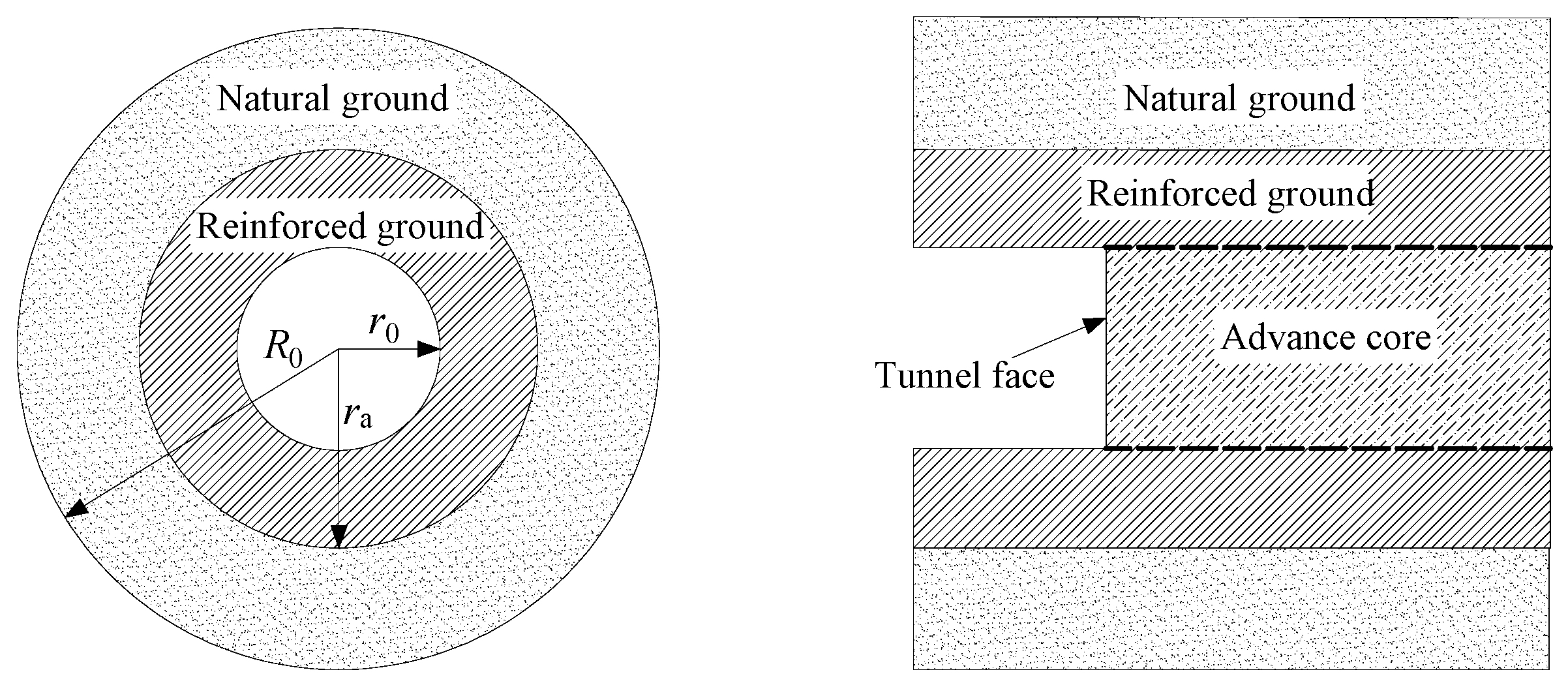
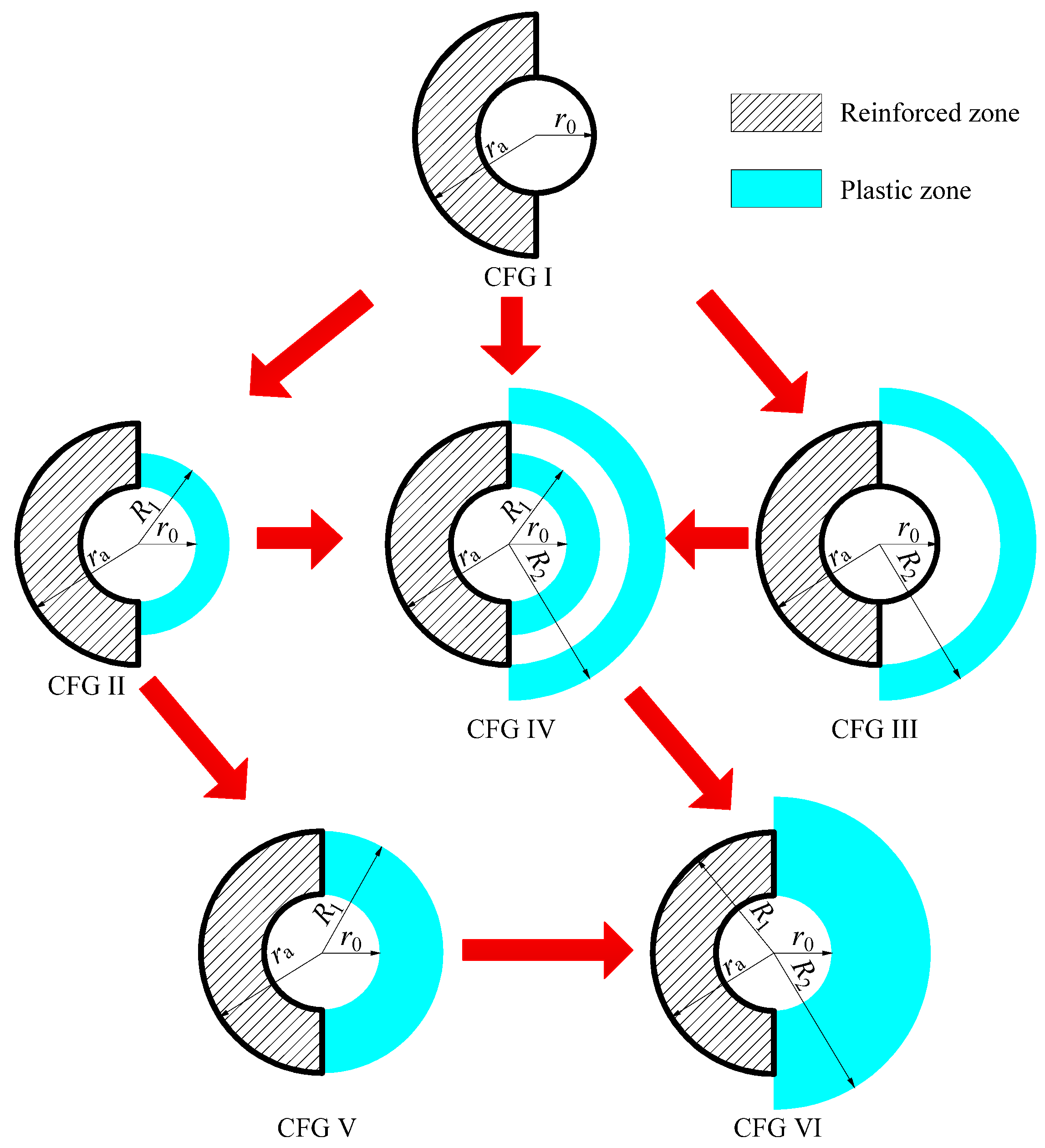

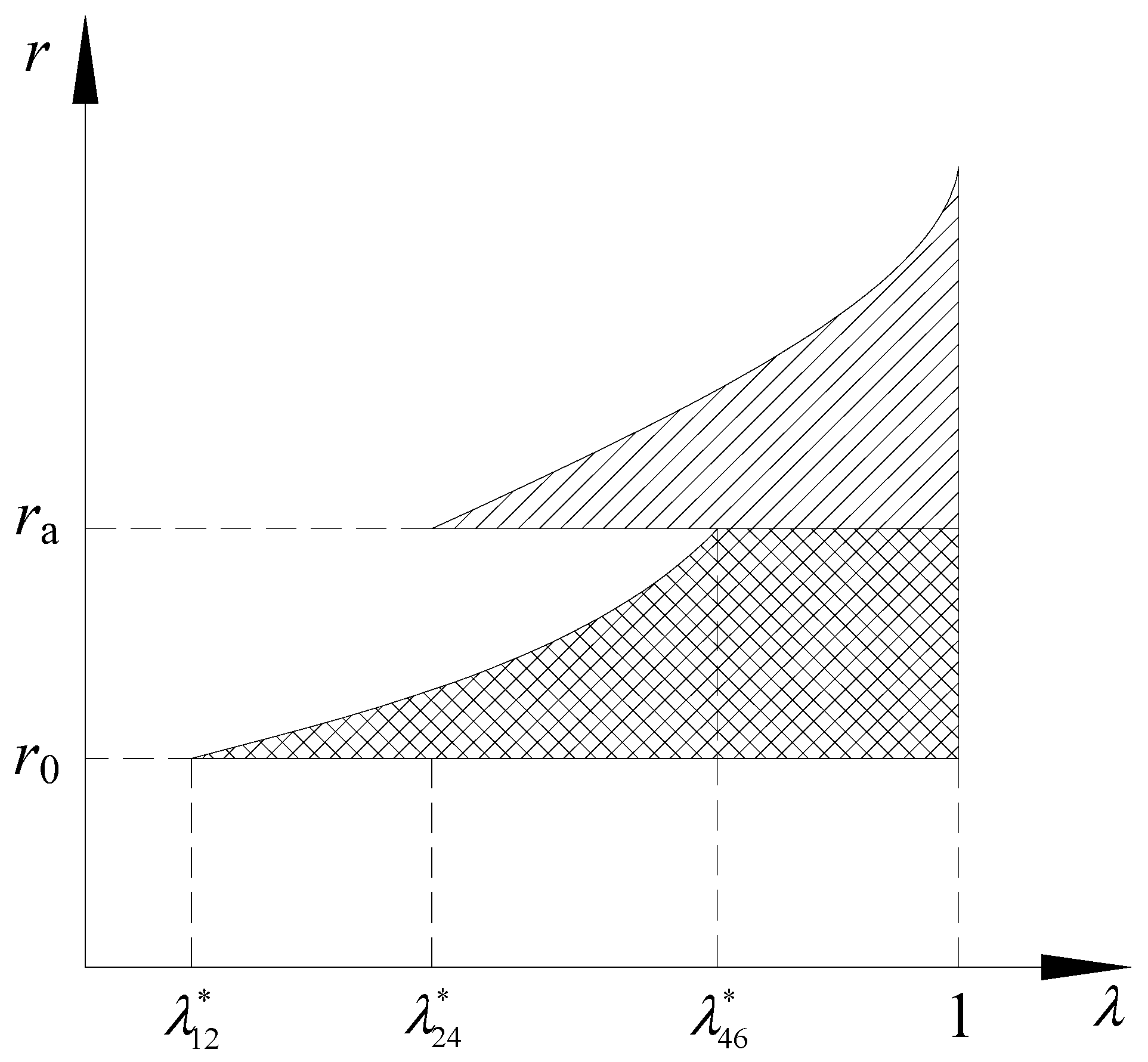
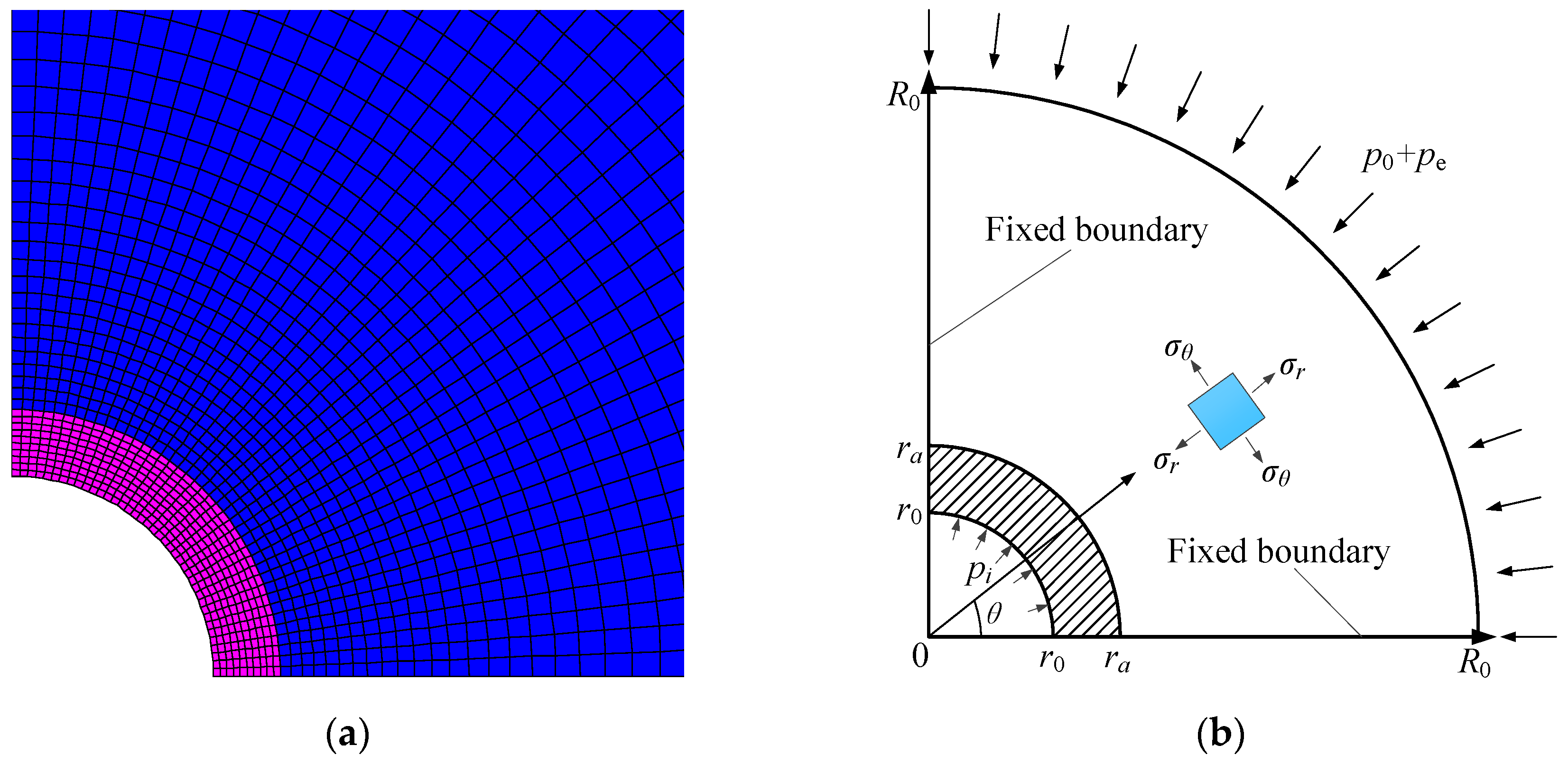

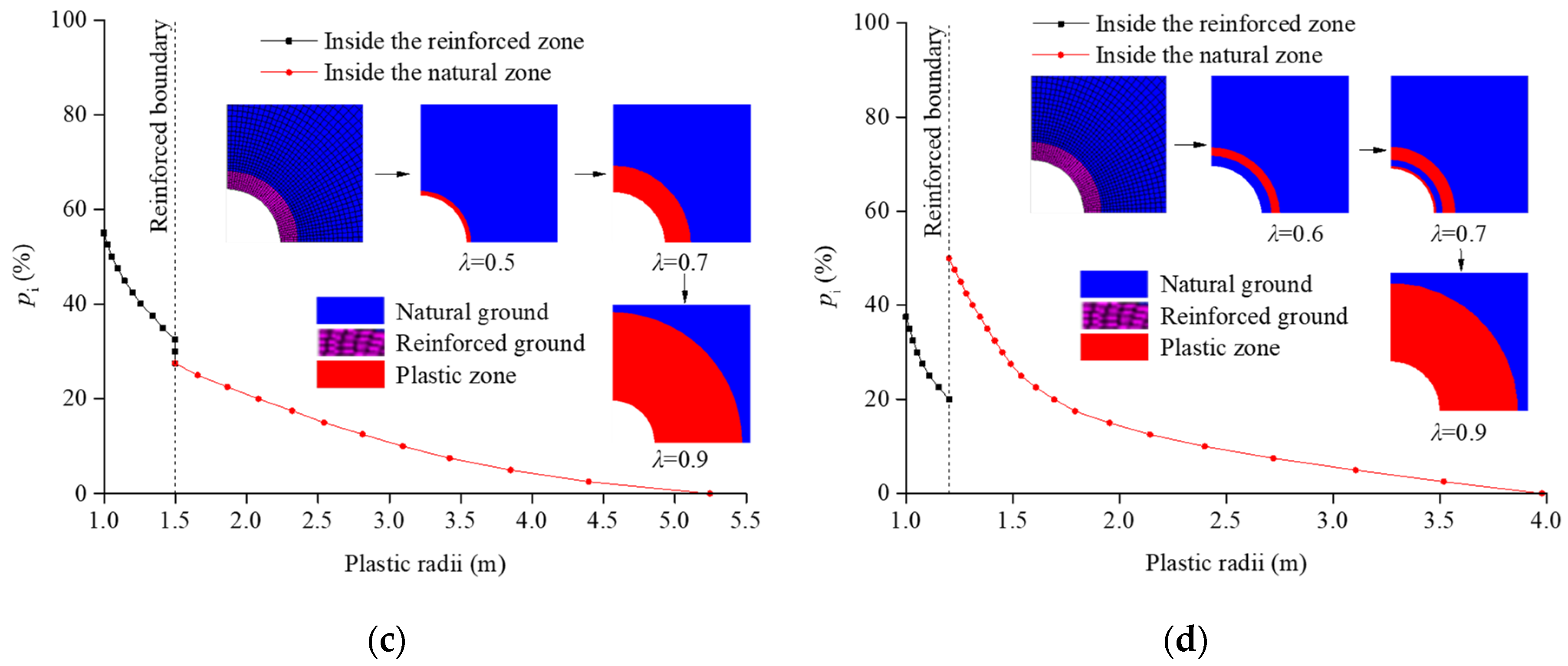
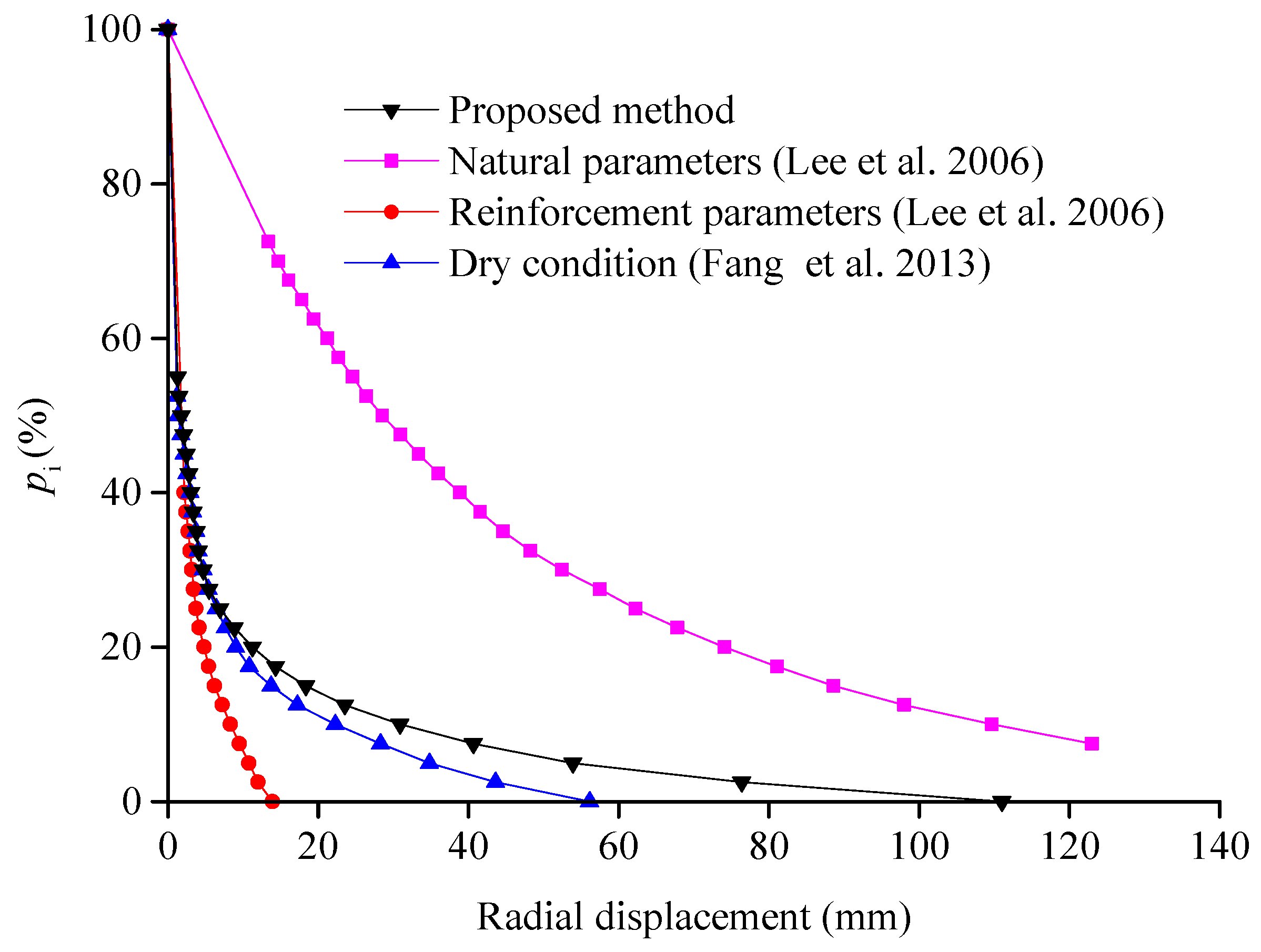
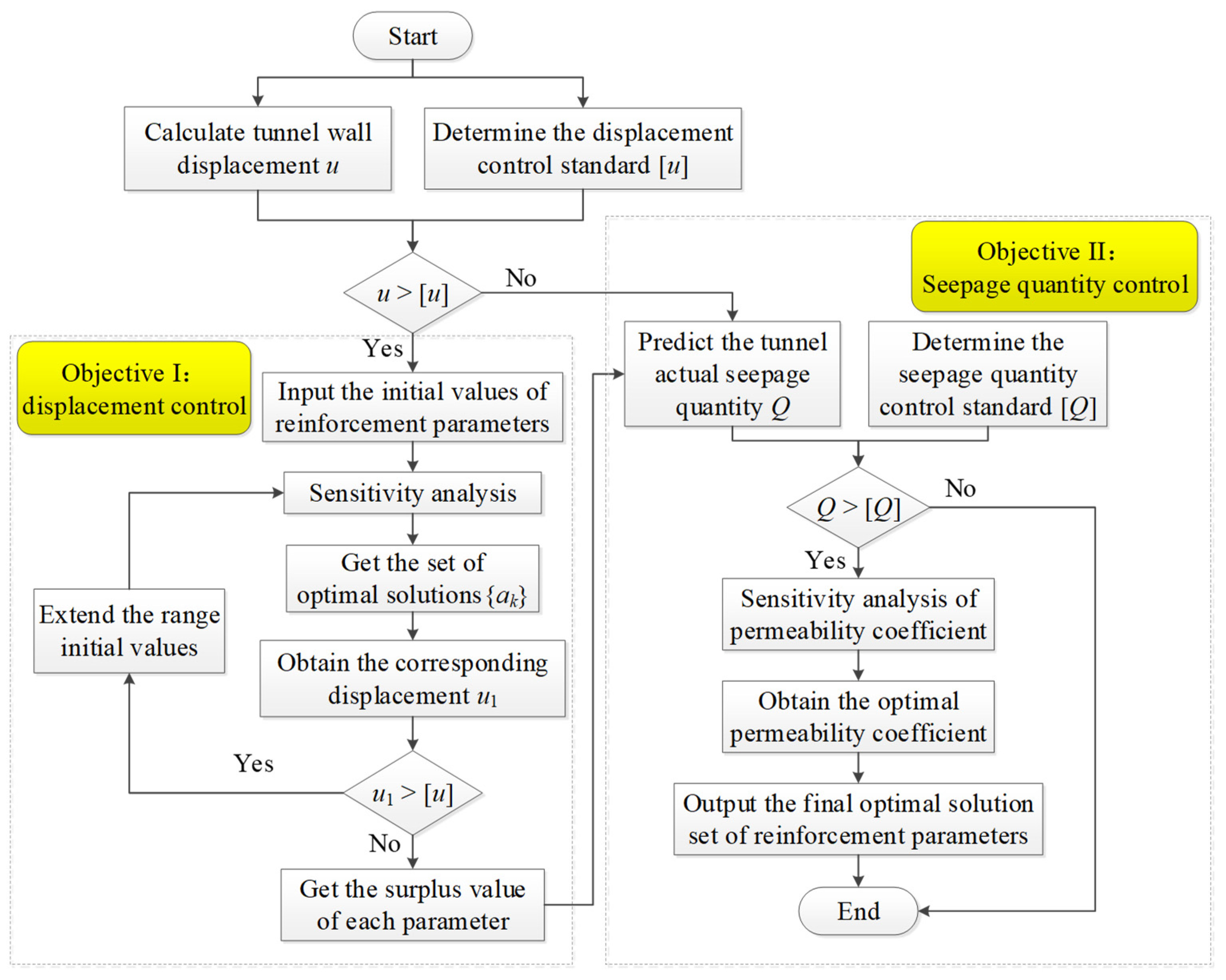
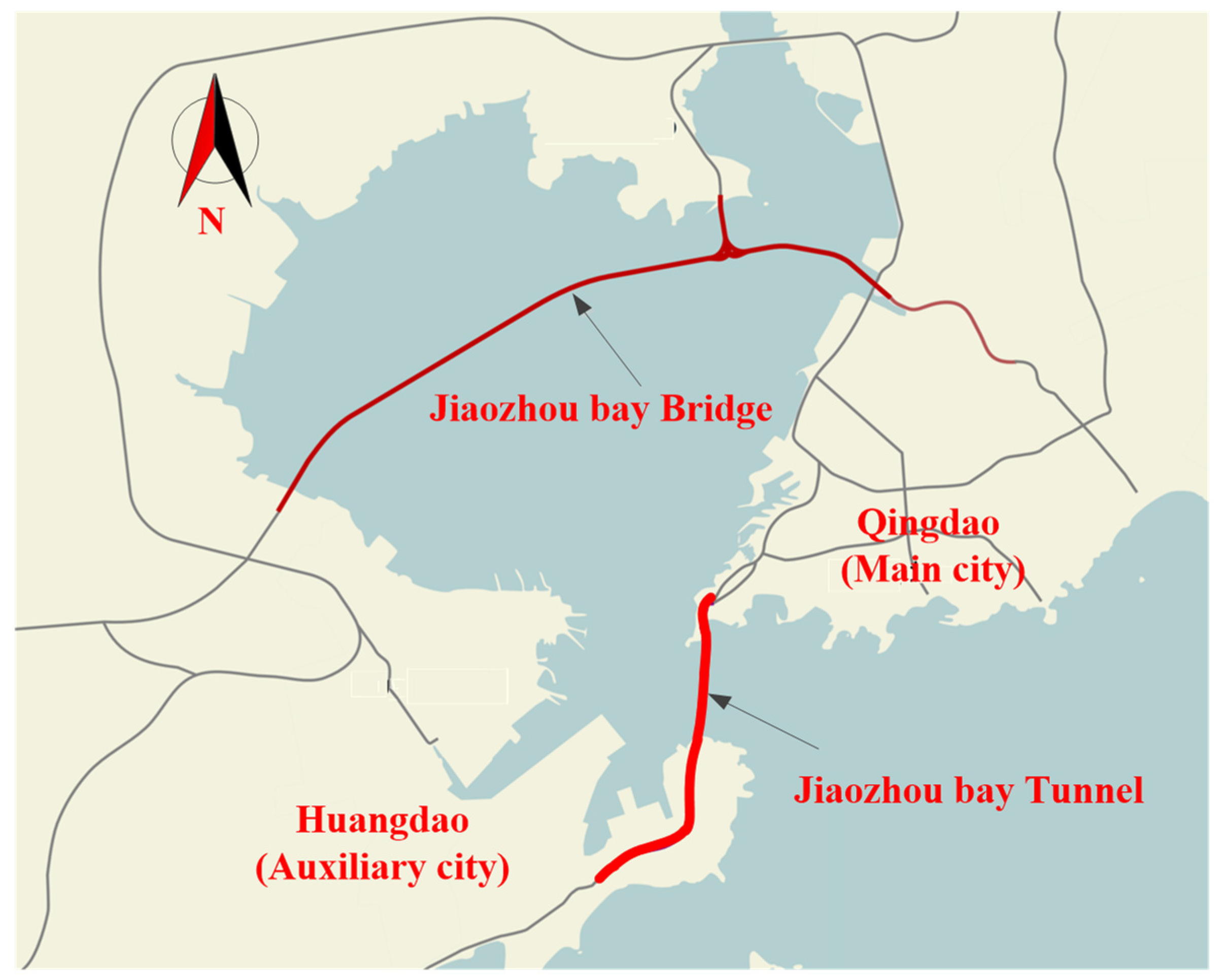


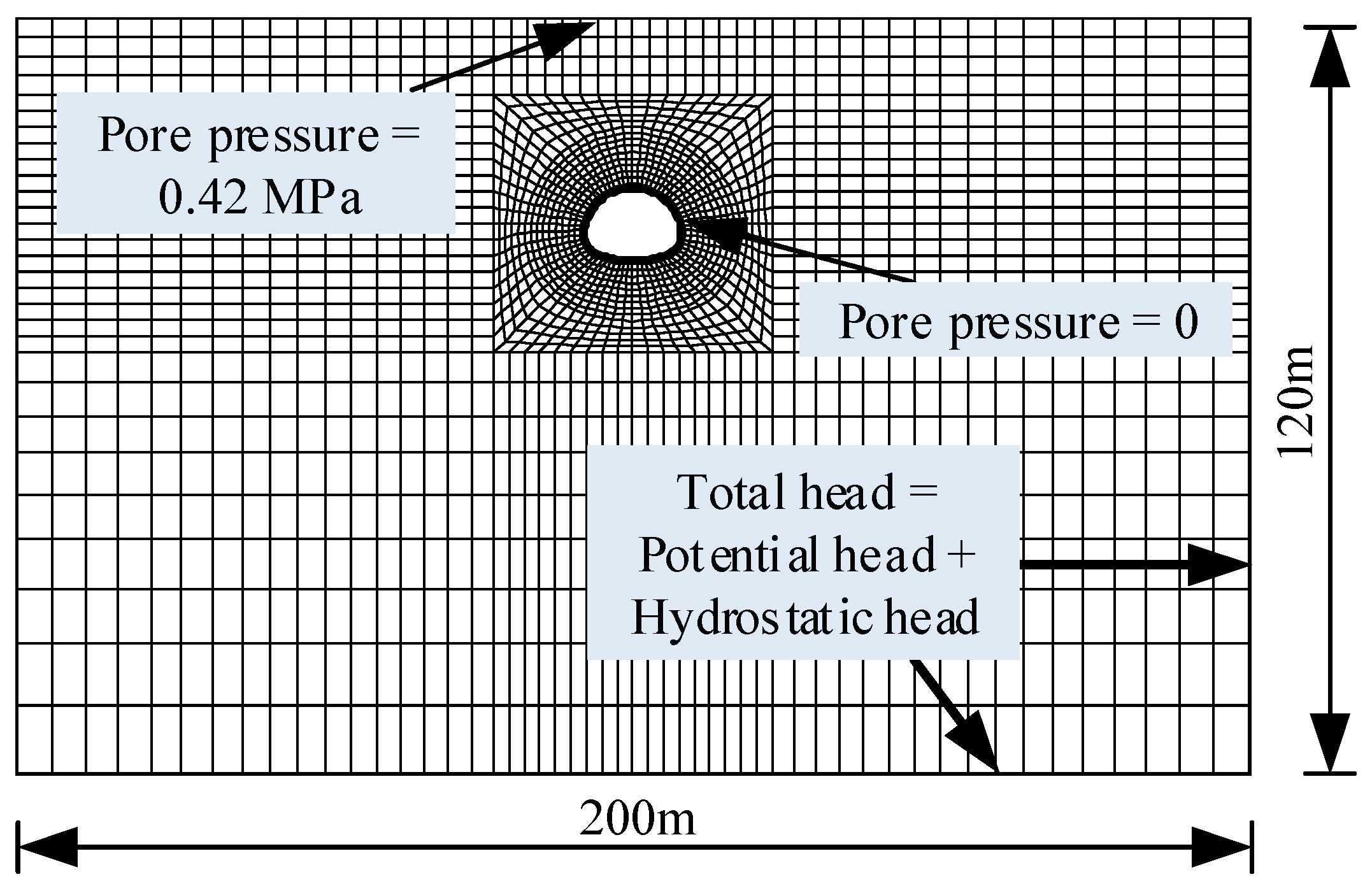
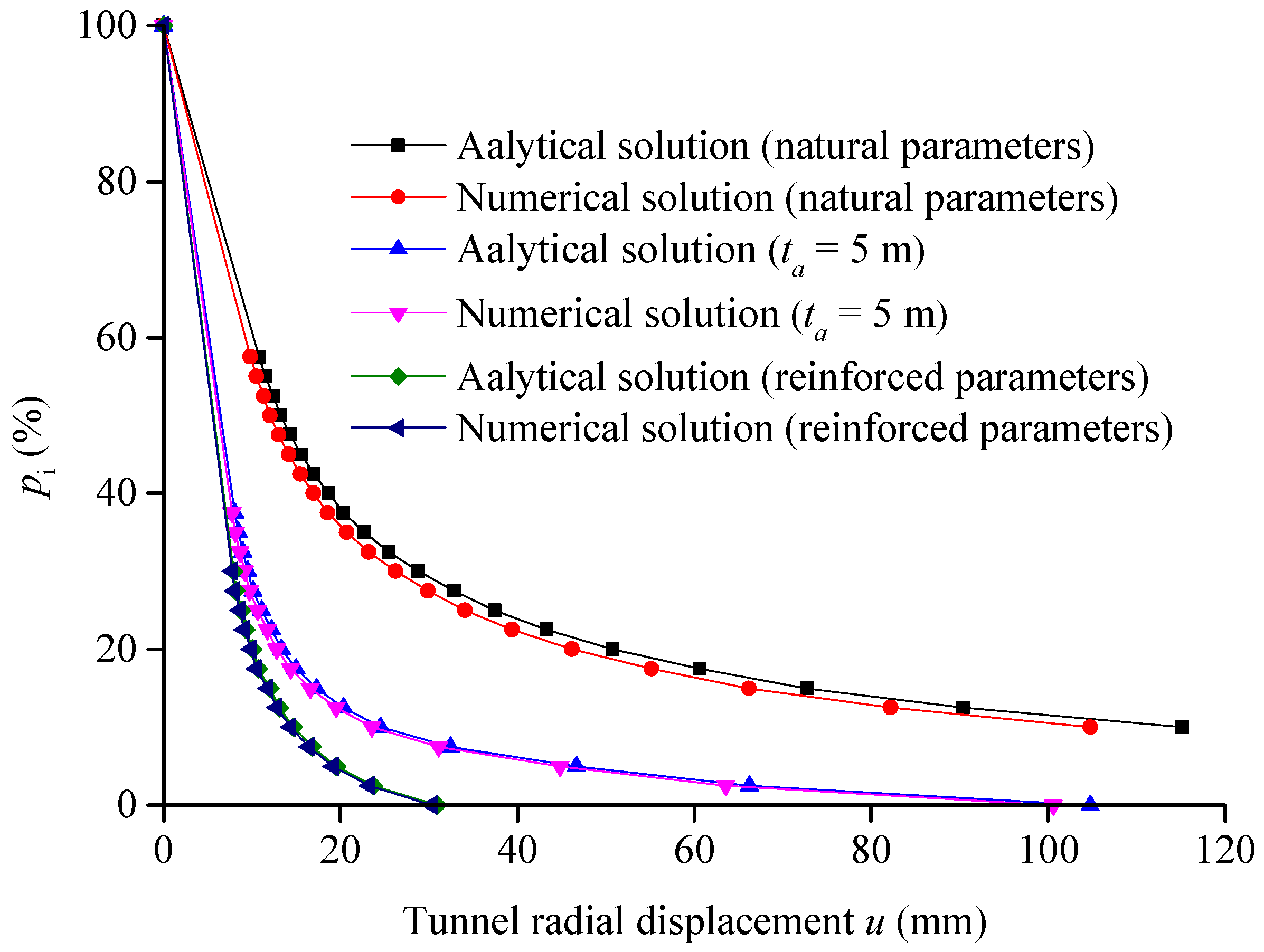
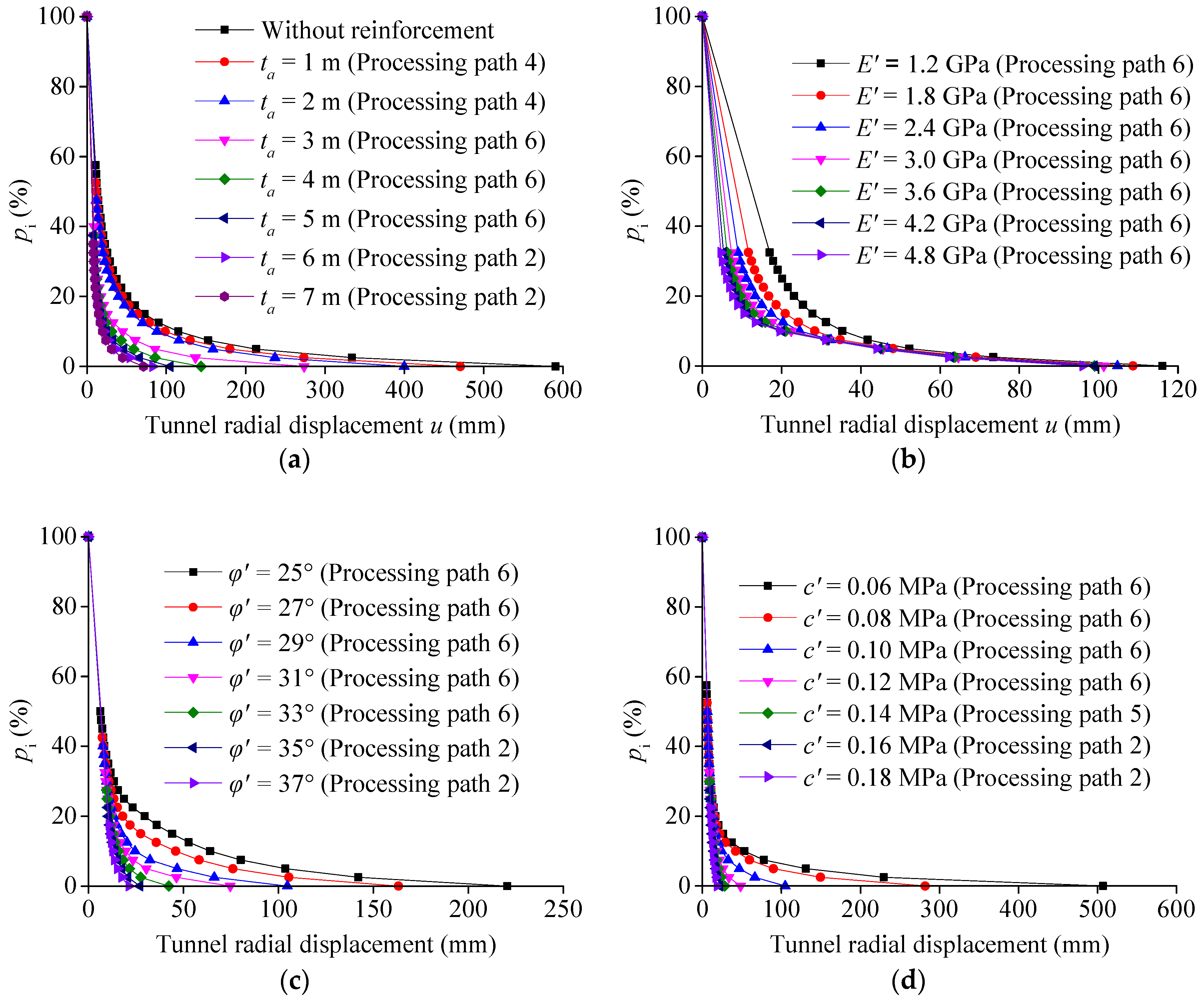
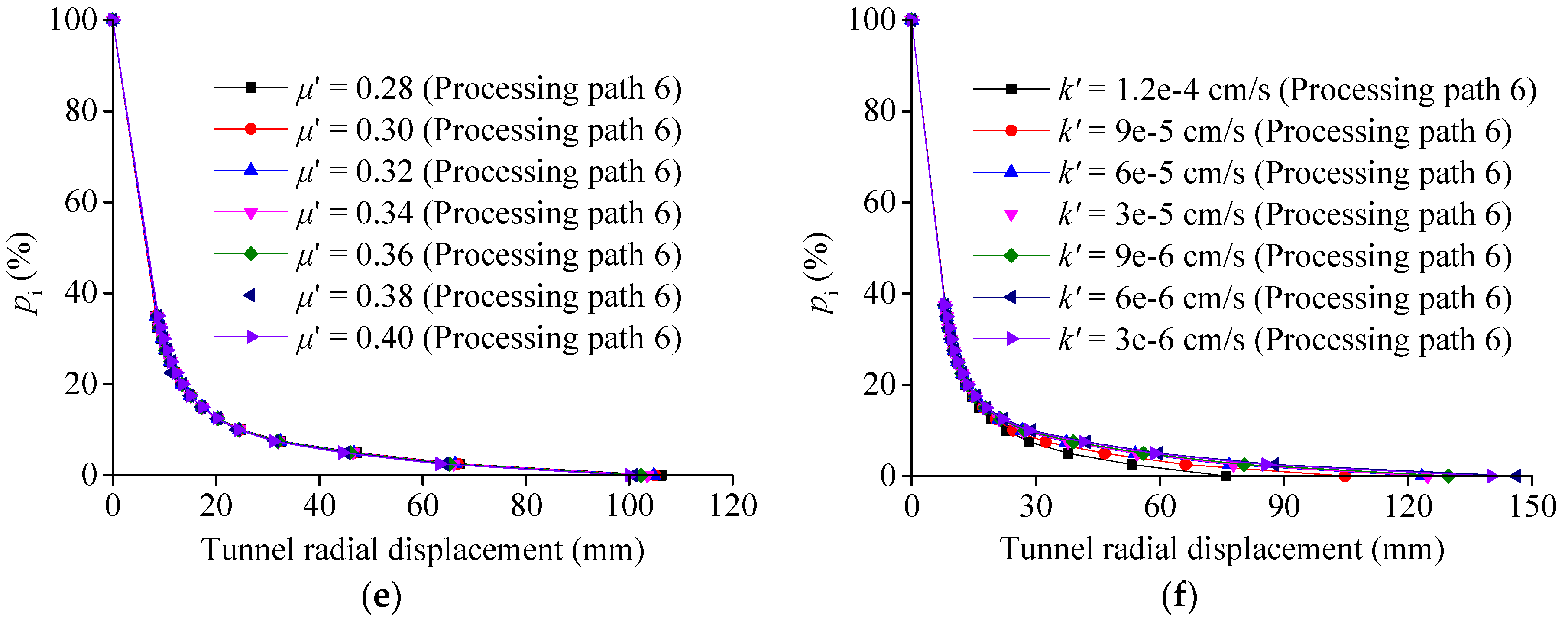
| Processing Path | Development History | Critical Unconfinement |
|---|---|---|
| 1 | I | - |
| 2 | I–II | |
| 3 | I–II–IV | , |
| 4 | I–II–IV–VI | , , |
| 5 | I–II–V | , |
| 6 | I–II–V–VI | , , |
| 7 | I–III | |
| 8 | I–III–IV | , |
| 9 | I–III–IV–VI | , , |
| 10 | I–IV | |
| 11 | I–IV–VI | , |
| Parameters | Case I (ra = 1.5 m) Processing Path 4 | Case II (ra = 1.5 m) Processing Path 6 | Case III (ra = 1.2 m) Processing Path 9 | |||
|---|---|---|---|---|---|---|
| NG | RG | NG | RG | NG | RG | |
| Elastic modulus (GPa) | 0.8 | 2.4 | 0.8 | 2.4 | 0.8 | 2.4 |
| Poisson’s ratio | 0.4 | 0.3 | 0.4 | 0.3 | 0.4 | 0.3 |
| Cohesion (MPa) | 0.1 | 1.0 | 0.3 | 0.8 | 0.2 | 2.2 |
| Internal friction angle (°) | 10 | 20 | 10 | 20 | 10 | 25 |
| Dilation angle (°) | 20 | 20 | 25 | 10 | 20 | 10 |
| Permeability coefficient (cm/s) | 6 × 10−4 | 3 × 10−4 | 5 × 10−4 | 2 × 10−4 | 5 × 10−4 | 2 × 10−4 |
| Processing Path | First-Round Decision | Second-Round Decision | Third-Round Decision | ||
|---|---|---|---|---|---|
| 4 | 0.525 | 0.752 | |||
| CFG II | CFG IV | CFG VI | |||
| 6 | 0.475 | 0.704 | |||
| CFG II | CFG V | CFG VI | |||
| 9 | 0.649 | 0.525 | |||
| CFG III | CFG IV | CFG VI |
| Zone | Elastic Modulus (GPa) | Poisson’s Ratio | Cohesion (MPa) | Internal Friction Angle (°) | Permeability Coefficient (cm/s) | |
|---|---|---|---|---|---|---|
| NG | 1.2 | 0.4 | 0.06 | 25 | 1.2 × 10−4 | |
| RG | Fiducial value | 3 | 0.34 | 0.12 | 31 | 6 × 10−5 |
| Range | 1.2~4.8 | 0.28~0.4 | 0.06~0.18 | 25~37 | 3 × 10−6~1.2 × 10−4 | |
| Parameters | Thickness (m) | Elastic modulus (GPa) | Internal Friction Angle (°) | Cohesion (MPa) |
|---|---|---|---|---|
| Sensitivity | 1.61 | 0.14 | 4.61 | 2.72 |
| Optimal value | 31 | 1.8 | 5 | 0.12 |
| Surplus value | 1 | 0.4 | 0.3 | 0.032 |
| Actual value | 30 | 3 | 5 | 0.2 |
© 2019 by the authors. Licensee MDPI, Basel, Switzerland. This article is an open access article distributed under the terms and conditions of the Creative Commons Attribution (CC BY) license (http://creativecommons.org/licenses/by/4.0/).
Share and Cite
Sun, Z.; Zhang, D.; Fang, Q. Determination Method of Reasonable Reinforcement Parameters for Subsea Tunnels Considering Ground Reinforcement and Seepage Effect. Appl. Sci. 2019, 9, 3607. https://doi.org/10.3390/app9173607
Sun Z, Zhang D, Fang Q. Determination Method of Reasonable Reinforcement Parameters for Subsea Tunnels Considering Ground Reinforcement and Seepage Effect. Applied Sciences. 2019; 9(17):3607. https://doi.org/10.3390/app9173607
Chicago/Turabian StyleSun, Zhenyu, Dingli Zhang, and Qian Fang. 2019. "Determination Method of Reasonable Reinforcement Parameters for Subsea Tunnels Considering Ground Reinforcement and Seepage Effect" Applied Sciences 9, no. 17: 3607. https://doi.org/10.3390/app9173607




